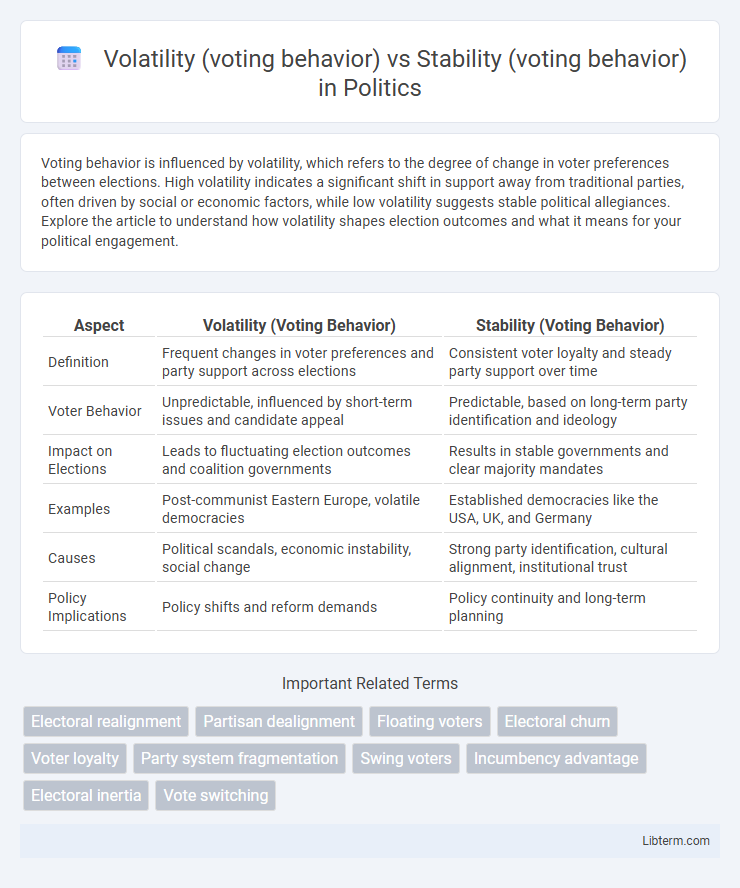Voting behavior is influenced by volatility, which refers to the degree of change in voter preferences between elections. High volatility indicates a significant shift in support away from traditional parties, often driven by social or economic factors, while low volatility suggests stable political allegiances. Explore the article to understand how volatility shapes election outcomes and what it means for your political engagement.
Table of Comparison
| Aspect | Volatility (Voting Behavior) | Stability (Voting Behavior) |
|---|---|---|
| Definition | Frequent changes in voter preferences and party support across elections | Consistent voter loyalty and steady party support over time |
| Voter Behavior | Unpredictable, influenced by short-term issues and candidate appeal | Predictable, based on long-term party identification and ideology |
| Impact on Elections | Leads to fluctuating election outcomes and coalition governments | Results in stable governments and clear majority mandates |
| Examples | Post-communist Eastern Europe, volatile democracies | Established democracies like the USA, UK, and Germany |
| Causes | Political scandals, economic instability, social change | Strong party identification, cultural alignment, institutional trust |
| Policy Implications | Policy shifts and reform demands | Policy continuity and long-term planning |
Understanding Voting Behavior: Volatility vs Stability
Voting behavior volatility reflects significant changes in electoral choices between elections, indicating shifting voter preferences, political realignments, or reactions to current events. Stability in voting behavior signifies consistent support for particular parties or candidates, often rooted in long-term social identities and ideological commitments. Analyzing volatility and stability provides insights into the dynamics of democratic participation, party system development, and voter loyalty.
Defining Volatility in Electoral Contexts
Volatility in electoral contexts refers to the extent to which voters switch their party preferences or support between elections, indicating fluctuations in political allegiance. This concept measures changes in voter behavior, often quantified through metrics like the Pedersen Index, which calculates the net shifts in party vote shares. Understanding volatility helps to assess the dynamic nature of political competition, contrasting with stability where voter loyalties remain consistent over time.
Stability in Voting Patterns: An Overview
Stability in voting patterns reflects consistent electoral preferences over multiple election cycles, indicating a well-established alignment between voters and political parties. High stability often correlates with strong party identification, demographic homogeneity, and institutional trust, reducing the frequency of vote shifts. This durability in voting behavior supports predictable election outcomes and reinforces representative democracy by maintaining a stable political environment.
Factors Driving Electoral Volatility
Electoral volatility is influenced by factors such as voter dissatisfaction, shifting party loyalties, and socio-political changes, which disrupt traditional voting patterns and increase electoral unpredictability. Stability in voting behavior often correlates with strong party identification, consistent ideological alignment, and institutional trust, maintaining predictable election outcomes. Socioeconomic variables, media influence, and campaign strategies also play critical roles in driving electoral volatility, reflecting the dynamic nature of voter preferences.
Causes of Stability in Voting Behavior
Stability in voting behavior often stems from strong party identification, consistent ideological beliefs, and socialization influences such as family and community norms that reinforce long-term political preferences. Demographic factors like age, education, and socioeconomic status contribute to entrenched voting patterns by shaping consistent policy priorities. Institutional factors, including electoral systems and candidate familiarity, further reinforce political stability by reducing uncertainty and encouraging habitual voter loyalty.
Social and Political Impacts of Volatile Electorates
Volatile electorates, characterized by frequent shifts in voting behavior, significantly impact political party strategies by forcing continuous adaptation to fluctuating voter preferences and undermining long-term policy consistency. Socially, volatility can increase political polarization and voter disenchantment, disrupting community cohesion and trust in democratic institutions. This instability challenges governments' ability to implement consistent policies, leading to unpredictable political landscapes and potential governance inefficiencies.
Benefits and Drawbacks of Voter Stability
Voter stability ensures consistent support for political parties, fostering predictable electoral outcomes and enabling long-term policy planning. Stable voting behavior strengthens party loyalty, reducing campaign costs and promoting political cohesion. However, it may limit political innovation and deter new voices, potentially leading to voter apathy and decreased democratic responsiveness.
Measuring and Analyzing Voting Volatility
Measuring voting volatility involves analyzing shifts in voter preferences between elections using indices such as the Pedersen Index, which quantifies the net change in party vote shares, reflecting political instability or realignment trends. Stability in voting behavior is indicated by consistent party support over time, often examined through longitudinal electoral data and voter surveys that track individual voting patterns. Statistical models and spatial analysis techniques help isolate factors driving volatility, enabling a clearer understanding of electoral dynamics and the resilience of political systems.
Electoral Systems and Their Effect on Voting Behavior
Electoral systems critically shape the volatility or stability of voting behavior by influencing party competition and voter loyalty; proportional representation systems typically encourage volatility through multiparty dynamics and shifting alliances, while majoritarian systems often promote stability via two-party dominance and consistent voter patterns. The degree of electoral volatility is linked to the electoral formula's inclusivity and district magnitude, affecting how voters perceive the efficacy of their vote and subsequently altering their voting choices. Empirical studies show that proportional systems correlate with higher electoral volatility rates, as they lower the barriers for new parties and encourage strategic voting shifts, contrasting with the stability fostered by single-member district plurality methods.
Future Trends: Volatility or Stability in Democratic Societies
Future trends in voting behavior indicate a nuanced balance between volatility and stability in democratic societies, influenced by shifting socio-political dynamics and evolving voter priorities. Increased access to information and social media platforms amplifies voter volatility, with electorates frequently reassessing party loyalties and policy preferences. However, structural factors such as institutional trust, electoral system design, and civic education continue to promote stability, reinforcing consistent voting patterns over time.
Volatility (voting behavior) Infographic

 libterm.com
libterm.com